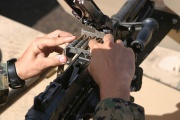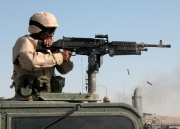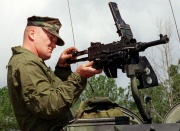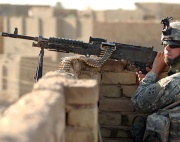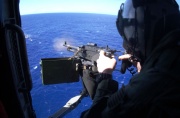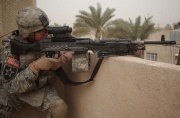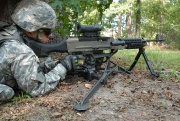M240 machine gun
| |||||||||||||||||||||||||||||||||||||||||||||||||||||||
The M240, formally Machine Gun, 7.62mm, M240, is a family of belt-fed, gas operated medium machine guns firing the 7.62x51mm NATO cartridge (w/ M13 Link). It is the US designation for the Belgian FN MAG 58 (Mitrailleuse d`Appui Général, "General Purpose Machine Gun") machine gun.
The M240 has been used by the United States armed forces since the mid 1990s. It is used extensively by infantry, as well as ground vehicles, watercraft, and aircraft. Despite not being the lightest medium machine gun in service, the M240 is highly regarded for reliability, and its standardization among NATO members is also seen as a major advantage.
All variants of the M240 series are fed from disintegrating belts, and are capable of firing most types of 7.62 mm NATO ammunition. All variants of the FN MAG 58, including the M240, can use European-type non-disintegrating belts (following replacement of a few easily-swappable parts). They all share the same basic internal parts, which are also interchangeable, for the most part, with other members of the FN MAG family. There are significant differences in weight and some features among some versions for which this does not apply. The M240 is manufactured by the American division of FN Herstal, a Belgian company with historically deep ties to U.S. arms procurement.
The M240B and M240G (see Variants section) are usually fired from a bipod, the M122A1 tripod, or other types of mounts.
Contents[hide] |
[edit] Development
Manufactured by Fabrique Nationale, the FN MAG was chosen by the U.S. military for different roles after large world-wide searches and competitions. It has mainly replaced the M60 in most roles, though it replaced some other machine guns in the coaxial position. M60s have remained in use, but they are being slowly phased out and replaced by the newer M240s as they wear out.
The M240 is a belt-fed, gas-operated, air-cooled, crew-served, established headspace weapon. It is compatible only with the M13 Link system, also used by many other western (especially NATO) machine gun designs. Its functionality is demonstrated by its ability to be mounted on the M122A1 tripod, a bipod, on vehicles, or on aircraft. The M60 is still, in some cases, used as a door gun on Army helicopters, however.
It was first adopted in 1977 by the U.S. Army as a coaxial tank gun, and slowly adopted for more applications in 1980s and 1990s. The M240 and M240E1 were adopted for use on vehicles. This led to further adoption in more uses, especially for the Army and Marine infantry. While possessing many of the same basic characteristics as its predecessor, the durability of the M240 system results in superior reliability when compared to the M60. The M240 actually has a more complex gas system than M60s, but can function better with lower maintenance with higher reliability, though this comes at greater cost and weight.
Compared to other machine guns, its rating of 26,000 Mean Rounds Between Failure (MRBF) is quite high for its weight—in the 1970s when it was first adopted it achieved about 7,000 MRBF. It is not as reliable as some very heavy older designs, but it is for its mass.
The U.S. Army is currently working on reducing the weight of the M240B by between four and seven pounds, in the M240B Weight Reduction Program.
[edit] Early history: testing and adoption
The adoption of the M240 has its origins in the late 1960s/early 1970s as a project to procure a new coaxially mounted 7.62 mm machine gun for tanks to replace the M73 and M219 machine guns then being used in this role. It would go on to be deployed in this role in the 1980s, but spawn its adoption for the infantry and other mountings as well. It would be deployed in this, and some other roles into the 1990s and 2000s.
As mentioned, during the 1970s the Army was looking for new 7.62 mm machine guns for vehicle/AFV mounts. The 1950s-era M73 had been rather troubled, and the M73E1/M219 it was developed into was not much of an improvement. A number of designs of the period from various countries were considered, but it was narrowed down to the M60E2 and the FN MAG. They underwent a large testing, including the older M219 as well.
Two main criteria analyzed were "Mean Rounds Between Stoppages" (MRBS, jams that can be cleared within minutes) and "Mean Rounds Between Failures" (MRBF, such as a part breaking). The results for the evaluated machine guns were the following:
| Type | Round Fired | MRBS | MRBF |
|---|---|---|---|
| FN MAG 58 | 50,000 | 2,962 | 6,442 |
| M60E2 | 50,000 | 846 | 1,669 |
| M219 | 19,000 | 215 | 1,090 |
| Minimum specified | 850 | 2,675 | |
| Minimum desired | 1,750 | 5,500 |
The test applies only to the 70s-era versions tested. The M240 itself underwent some improvements and the M60E2 was a specialized coaxial variant that differed from some of the other types. The qualities of the M60 variants vary considerably, such as between the M60E4 and the M60C. That aside, for these types the clear winner was the MAG, which was designated as the M240 in 1977 after the Army competition. It went on to replace many older types for the vehicle/coaxial role in the 1980s. The M240 proved popular enough that it would be adapted by the infantry later on, spawning the M240B and M240G. It was adopted for this role in 1991 by the USMC, replacing the rather worn M60s used by infantry, but also the M60E3 that the Marines had started using in the 1980s. The M240 would be adopted in the late 1990s by the Army for infantry, beating out the M60E4, which though lighter and cheaper did not offer commonality with the vehicle borne M240, other NATO FN MAG users such as Britain, or the USMC.
The various versions of the M240 never entirely replaced all the M60 versions, though it did for most main applications and roles.
[edit] Variants
The NATO version of the M240 is known as the MAG 58, in the UK it is known as the L7 General Purpose Machine Gun. The U.S.-made M240 family is produced under the same specifications as the MAG 58, enabling all M240 variants to have interchangeable/interoperable components with foreign-produced NATO equivalent weapons. This has significant advantages in training, logistics support, tactical versatility, and joint operations. For example, an M240B's buttstock and bipod may be carried in a vehicle to enable the crew to convert the coaxial weapon to an infantry model in the event that they are forced to withdraw from an inoperable vehicle. This is referred to as an "egress kit" by the manufacturer.
[edit] M240
This was adopted in 1977 by the Army to replace the M73 and M219 7.62 mm machine guns, and the M85 .50 cal. In the 1980s, the Marines adopted the M240 and M240E1 for use on vehicles like the LAV-25.
[edit] M240E4/M240B
The M240B is the standard infantry medium machine gun of the U.S. Army and recently, the United State Marine Corps. This the version is also in use by the U.S. Air Force. It comes configured for ground combat. It is almost always referred to as an "M240 Bravo" or even a "240 Bravo" verbally, but always written as M240B.
The M60E4 (Mk 43 as designated by the U.S. Navy) was pitted against the (then called) M240E4 in Army trials during the 1990s for a new infantry medium machine gun, in a competition to replace the decades-old M60s. The M240E4 won, and was then classified as the M240B. This led to 1000 existing M240 being sent to FN for an overhaul and a special kit that modified them for use on ground (such as a stock, a rail, etc.). This led to procurement contracts in the late 1990s for all-new M240B. However, a new feature was added, a hydraulic buffer system to reduce the felt recoil as incorporated in the M60. While the M240B had been more reliable in the tests, it was a few pounds heavier than the M60E4, and there is program underway for a new lightweight medium machine gun in the early 2000s. The Army M240 converted to the M240B configuration should not be confused with the large numbers of M240/E1 converted to the M240G configuration for the Marine Corps.
[edit] M240C
The M240C is a variation on the original coaxial M240, but with a right-handed feed. This variant is used on the M2/M3 Bradley Fighting Vehicle as the coax machine gun, as well as on the Abrams.
[edit] M240E1 and M240D
The M240D has two possible configurations: aircraft and egress (ground). The aircraft configured M240D has a front and rear sight and a trigger group which accommodates the spade grip device. The ground configuration involves the installation of an Egress Package or "infantry modification kit" which is designed to provide downed aircrew personnel with increased fire power. The M240D is an upgrade of the M240E1, primarily in the addition of an optical rail on the receiver cover. The M240E1 had also fitted with spade grips for flexible use.
[edit] M240G
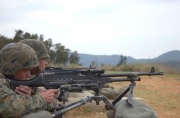
The M240 allows for commonality throughout the Marine Corps whether the weapon is used in an infantry, vehicular, or airborne role. The M240G is the ground version of the original M240 or M240E1, 7.62 mm medium class weapon designed as a coaxial/pintle mounted machine gun for Tanks and LAVs. The M240G can be modified for ground use by the installation of an "infantry modification kit", (a flash suppressor, front sight, carrying handle for the barrel, a buttstock, infantry length pistol grip, bipod, and rear sight assembly). The M240G lacks a front heat guard, and as such is a few pounds lighter than the M240B, weighing in at 25.6 lb. The M240G has three gas settings, allowing this weapon fire between 650 and 950 rounds per minute at the cyclic rate.
[edit] M240E5/M240H
An improvement of the M240D, the M240H features a rail equipped feed cover, an improved flash suppressor, and has been configured so that it can be more quickly converted to infantry standard using an Egress Kit. The M240H is 41.2 inches long with a 23.6 inch barrel, and weighs 26.3 pounds empty.
[edit] M240E6
The M240E6 (or M240B Weight Reduction Program), is intended to reduce the weight of the existing M240B between four pounds (minimum) and seven pounds (objective). This program will evaluate high-performance lightweight materials, such as titanium, and alternative manufacturing methods in fabricating major M240B components. The resulting improvements will reduce the Soldier’s combat load while allowing easier handling and movement of the weapon. This lighter-weight model that features a titanium receiver which is currently under development. [2]
[edit] Operation
Loading the weapon is performed by pulling the charging handle which locks the bolt to the rear. The weapon is placed on safe and the charging handle is pushed forward (this is spring loaded on the tank mounted version). The feed tray cover is then lifted and rounds are laid inside the feed tray. The feed tray cover is then closed and the weapon is ready for operation.
Clearing the weapon is performed by ensuring the bolt is locked to the rear and the weapon is on safe. The feed tray cover is then lifted, the remaining belt (if any) is swept out of the feed tray, the feed tray is lifted to visually inspect the rear of the barrel and the face of the bolt. Any links or brass casings are removed. The weapon is now clear. In the unlikely event that a live round is on the bolt face, it is knocked loose with a cleaning rod or another rigid object. If there is a live round lodged in the barrel, the operator must immediately decide if the barrel is hot enough that there is a chance of it cooking off. If there is, he will immediately move his face away from the opening of the weapon. He should then wait for the barrel to cool off before attempting to remove it. In many cases, attempting to remove the barrel will cause the round to detonate as soon as the barrel is unlocked from the receiver. He can also attempt to extract the round by taking the weapon off of safe, pulling the trigger and pulling back on the charging handle. This has a fair chance of causing the weapon to fire, so care should be made in ensuring that the weapon is pointed in a safe direction first.
The rate of fire may be controlled by three different settings. The first setting allows the weapon to cycle at 750 round/min. The two remaining settings increase the rate of fire by 100 round/min per setting — second setting being 850 round/min and third setting, 950 round/min). These settings are changed by dismounting the barrel, removing the gas regulator collar and turning the gas regulator to allow more or less gas to move through the weapon system. It is generally performed before missions, as changing the setting is distracting at best under field or combat conditions.
The barrels can be exchanged rapidly, thanks to a barrel release button located on the left side of the weapon. The weapon is cleared first and then the button is held down, while the barrel's carrying handle is moved from the right side of the weapon to the center, unlocking it from the receiver. At this point, the button is released and the barrel is then pulled free of the receiver and placed to the side. The new barrel is inserted into the receiver and then the carrying handle is shifted to the right, locking it into place.
During prolonged firing, care must be taken to not allow exposed skin to come in contact with the weapon. The barrels can become hot enough to inflict second degree burns instantly without becoming visibly different. However, such barrels glow brightly to anyone using any sort of optics sensitive to infrared radiation, such as night vision devices.
[edit] Feedback on the M240B
The M240B is a successful and well-regarded weapon system that has proven itself in combat in Afghanistan and Iraq, serving as a powerful supplement to the lighter 5.56mm-based M249, M16 and M4. Its 7.62mm round provides good penetration and stopping power, a characteristic that is especially appreciated in the urban environments that many Iraq engagements take place in. Overall, the M240B's combat record must be considered superior to the problematic M60 it has for the most part replaced in US service. An April 2002 presentation by the Natick Soldier Center reported on lessons learned from M240B use in Afghanistan:
- 17% reported engaging the enemy with their M240B;
- 42% reported problems getting spare parts in Afghanistan (barrels, springs, small roll pins, T&E pin, heat shields, sear pins, spare barrel bag, cleaning materials);
- 1 soldier reported a double feed in combat;
- 50% reported that they need better ways to carry ammunition (ammo bag, etc);
- 100% were confident in their weapon;
- 82% felt that their M240B was reliable;
- Suggestions: improved sling, lighter, more durable tripod, more durable heat shield.
On 15 May 2003, An "Operation Iraqi Freedom PEO Soldier Lessons Learned" report by LTC Jim Smith, US ARMY, was published. The report made the following comments on the M240B:
Soldiers have great confidence in this weapon. Again, the vast majority of comments were positive. Most negative comments were relative to the AG’s load. Soldiers recommended fabricating the tripod out of a lighter material. The AG bag is not integrated into the remainder of the MOLLE and, therefore, is not easily carried. Additionally, the nylon bag melts when it comes in contact with a hot barrel. Other suggestions included adding collapsible bipod legs like the squad automatic weapon (SAW), wiring down the heat shields and an ammunition carrying system to carry 300-400 linked rounds.
A May 2006 presentation by the US Army Infantry Center reported these conclusions on the M240B:
- Soldier ratings consistently highly positive
- Great rate of fire and target effects
- Good durability
These comments were based on a survey of 3,300 soldiers from eight divisions of the US Army (Active, Guard and Reserve).
[edit] See also
- MG3 (7.62mm machine gun)
- CETME Ameli
- M249 Squad Automatic Weapon (5.56 mm machine gun)
- M60 machine gun (7.62 mm machine gun)
- Mk 48 Mod 0 (M249-derived 7.62 mm machine gun)
[edit] Resources

This article or section is missing resources, such as diagrams or manual links, and could use more input to fill in the missing bits. You (yes, you!) can help Gunsopedia provide more comprehensive information to our users by using your own knowledge to add to it.
[edit] Notes
[edit] External links
- Chapter 3, M240B Machine Gun, Field Manual 3-22.68, Crew-Served Machine Guns, 5.56-mm and 7.62-mm, Department of the Army, 31 January 2003
- Federation of American Scientists: M240
- Video #1 of M240
| [show] |
|---|

